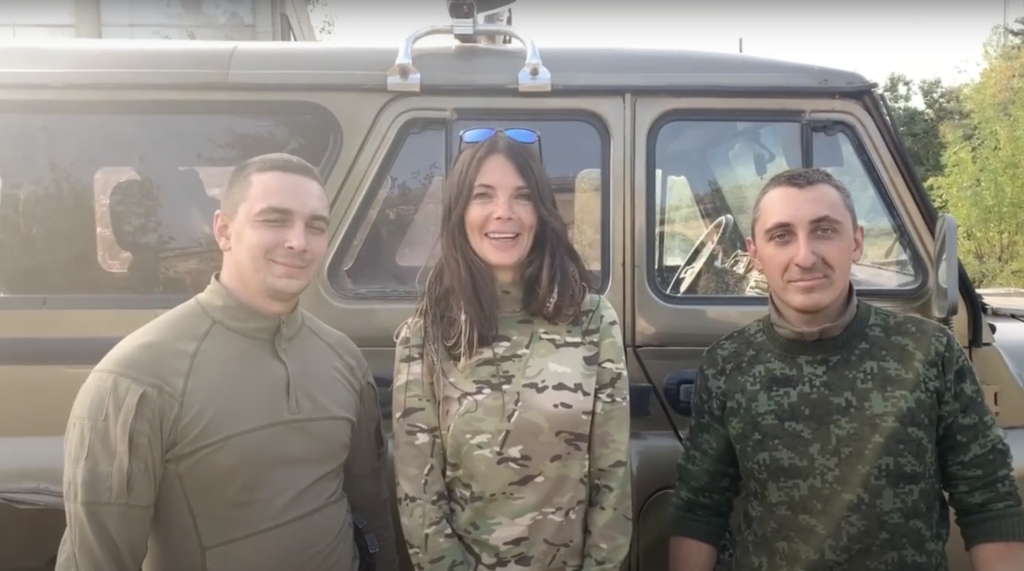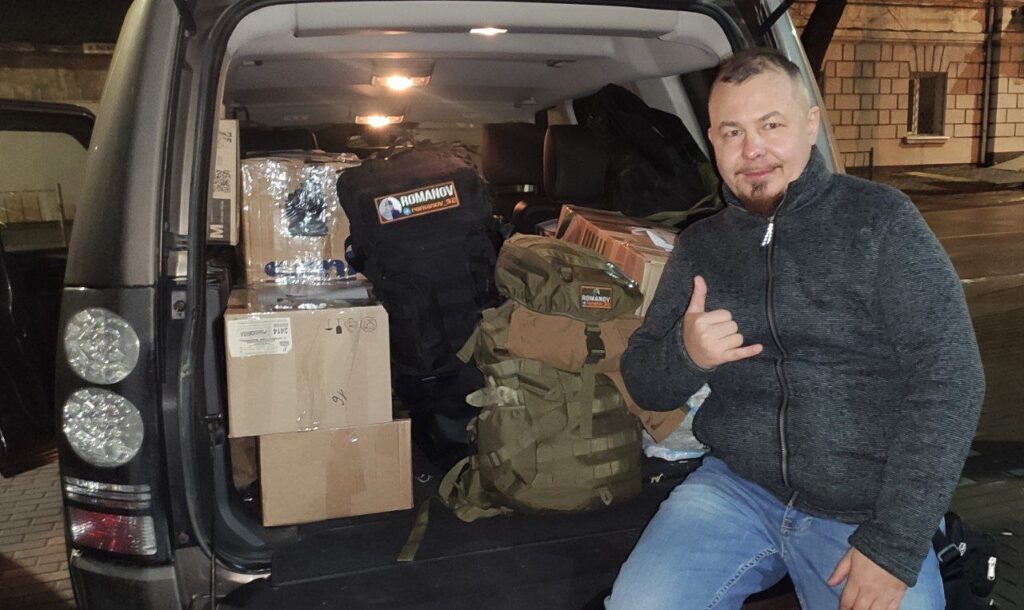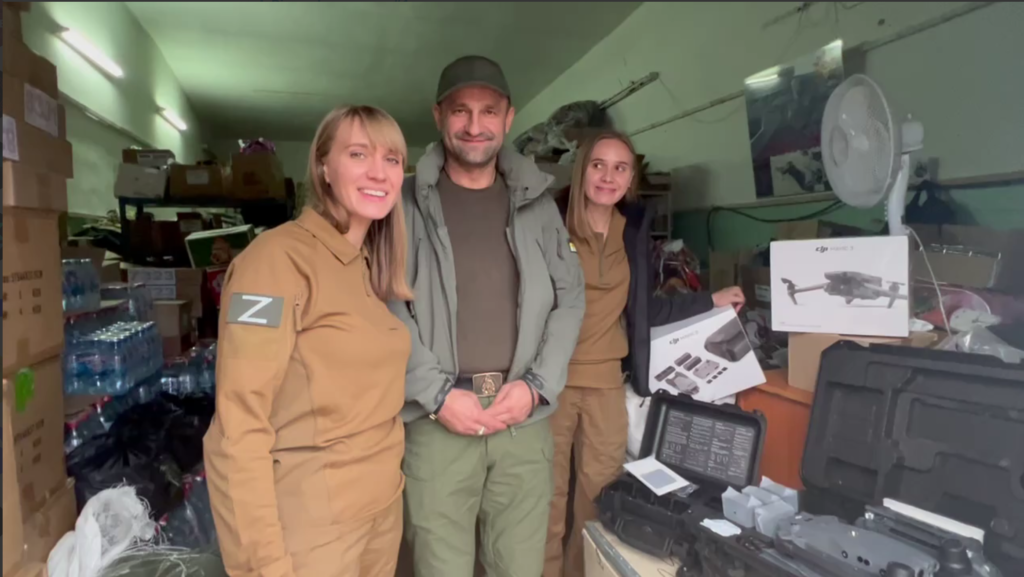
“Sanctions are good. They prove us right.”
When I asked Alexander Lyubimov if he feared being placed on an international sanctions list, he replied:
“I am personally aiming to be sanctioned. I think the sanctions are a sign that my efforts have been recognized. For example, being put on the list of nominees for war crimes.”
Lyubimov is the director of the Novorossia Aid Coordinating Center (NACC), which raises funds for Russian forces in Ukraine. Of the more than 20 pro-war Russian fundraisers CoinDesk contacted, Lyubimov was the only one who responded to a phone call.
Crypto assets as a fundraising tool
NACC will invest at least $1.8 million in crypto assets to provide ammunition, guns, surveillance drones, vehicles, winter clothing and more to the struggling Russian military in Ukraine. It is one of many official and unofficial organizations in Russia that have collected 1 dollar = 130 yen).
While it seems small compared to the money raised by Ukraine, and the fundraising efforts are much less prominent, some civilian Russian efforts have successfully raised hundreds of thousands of dollars for specific units. There is also
Sanctions against Russia for its February 2022 invasion of Ukraine have boosted the popularity of cryptocurrencies as a fundraising tool for pro-Russian groups and influencers. It is now the only functioning means of donation for pro-Russian people abroad.
According to CoinDesk’s analysis, most of the aforementioned $1.8 million came from centralized firms such as Russian exchanges Garantex and Bitzlato, both of which are suspected of processing large amounts of criminal funds. through an exchange. However, significant amounts of money also flowed to internationally popular platforms such as Binance and Huobi.
Meanwhile, Ukrainian volunteers seek out and report such wallets, aiming to freeze the funds. Sometimes it succeeds.
‘Protecting the land’
NACC’s Lyubimov is not joking when he says he wants his efforts to be investigated as part of the International Court of Justice’s investigation into Russian war crimes.
Although he does not consider himself to have committed a war crime, he uses the term in defiance. “Our enemies call it a ‘war crime’, but I consider myself defending the homeland,” Lyubimov said.
The NACC has been active since Russia’s annexation of Crimea in 2014, sparking armed opposition in southeastern Ukraine.
The NACC raises funds to support pro-Russian regions that have unilaterally declared independence, the Donetsk and Luhansk People’s Republics, as well as local militants fighting the Ukrainian army. One of the NACC’s leaders, Alexey Markov, has even joined the leadership of the rebels. He died in a car accident in 2020.
Lyubimov said NACC has been using cryptocurrencies alongside fiat currency for years to collect donations. And the war and sanctions against Russia made crypto even more important.
Before the war, NACC only supported Bitcoin (BTC). After the outbreak of the war, Ethereum (ETH) and Tether (USDT) were added and donations increased in response to calls for other cryptocurrency options.
 Drone purchased by Alexander Lyubimov and the NACC for the Russian military
Drone purchased by Alexander Lyubimov and the NACC for the Russian military(screenshot from video by NACC)
“We also used PayPal before, but it was often blocked and it no longer functions as a tool for donations from overseas. Many people living far away want to support our efforts. crypto assets are currently the only tools available to them.”
“Look at the Darknet”
According to Lyubimov, Russian military supporters donating to the NACC are scattered across Europe, Australia, the United States and other countries.
Lyubimov said NACC long ago figured out a way around exchanges blocking crypto assets. When he asked how it was done, the answer was vague.
“Look at the Darknet. Everything was invented way before we did it. People are running different businesses in secret and they’re detailing how to do it right and wisely.”
When asked if he bought verified exchange accounts in someone else’s name, he neither confirmed nor denied.
Since the start of the war, NACC has collected 1.3 BTC, 2.75 ETH, and 5,700 USDT in wallets published on its website. The total amount is equivalent to $ 40,500 (about 5.3 million yen). Blockchain analytics firm TRM Labs saw $21,000 in NACC wallets in September, indicating an acceleration in donations over the fall and winter.
CoinDesk, along with researchers from Ukrainian cryptocurrency startup HAPI monitoring the flow of such funds, discovered a number of wallets raising funds for the Russian military. Then, with the help of blockchain analytics firm Crystal Blockchain, we examined how cryptocurrencies flowed from donors around the world to the Russian military in Ukraine.
Russia in need of a lot of money
War costs money.
For the ill-equipped Russian military, consistent funding is essential to purchase everything from surveillance drones to winter clothing. At least that’s what pro-war influencers are telling their Russian followers to solicit donations.
A portion of such donations are made in crypto assets.
“Ammunition was needed. We also bought warm underwear, socks and winter boots,” Anastasia Mikhaylovskaya, a Russian right-wing celebrity who raises money for the Russian army, said in December. speaks in an interview. The Russian military is apparently “completely unprepared” for a winter war, as she “didn’t expect the campaign to last this long.”
Mikhailovskaya has many faces. She is a film actress, a well-known billboard for the Russian far-right, and an associate of conservative political activist Alexander Dugin and the aforementioned republic’s leaders seeking independence from Ukraine. She is actively fundraising for food, clothing, medicine, bulletproof vests and helmets, drones, and more, and in a December interview, her team said it would raise 400 million rubles ($7.3 million). She said she had raised more than that.
The wallet Mikhailovskaya posted on her website for donations contains 6.3 ETH worth about $34,000 (approximately ¥4.4 million), more than 25,000 USDT, since the February 24, 2022 invasion. has been sent. More donations have been made to the wallet, which was announced on Telegram’s anonymous channel soliciting donations in the name of Mikaylovskaya.

 Screenshot of Anastasia Mikhailovskaya’s video
Screenshot of Anastasia Mikhailovskaya’s videoSource: YouTube
Several pro-Russian fundraisers, including NACC’s Lyubimov, who spoke to CoinDesk said cryptocurrencies represent only a small percentage of all donations and not many donors use them. .
Hacking is also a way
According to CoinDesk’s analysis, among those fundraising for Russia’s war, the NACC and Mikhaylovskaya’s team appear to be the most efficient cryptocurrency fundraiser. I have received a significant amount of crypto assets. But there are groups that are raising even more donations.
For example, the right-wing militia group Rusich, which is linked to the private military company Wagnar and is also subject to US sanctions, has collected 2.7 BTC, 30 ETH, etc., worth more than $212,700 (about 27.7 million) since the start of the war. According to Rusic’s Telegram group, the donations have been used to buy radio equipment, ammunition and clothing.
Donations aren’t the only source of funding for Lucic. According to Russian media outlet Medusa, Rusic hacked the website of a Ukrainian charity fund at least once, replacing one of the Ethereum addresses with his own.
At 24.6 ETH, the wallet had amassed more crypto assets than any other Lucich wallet. Rusic leader Alexey Milchakov has admitted to Medusa that cybercrime is one source of funding.
bloggers and sister influencers
Vladimir Romanov is also one of the influencers who collects a lot of donations. A blogger living in Crimea who became famous after the outbreak of the war.
Last spring, Mr. Romanov began posting videos of frightened-looking Ukrainians apologizing for criticizing the Russian military on social media. The videos may have been filmed inside a Russian military tent, according to Novaya Gazeta Europe, a European news site started by staff of the Russian newspaper Novaya Gazeta. there is
On his channel, Romanov provides updates on the Russian military’s advances, often posing in military uniform next to missile launchers. He is raising money to buy drones, vehicles and other equipment for various units of the Russian military, including rocket artillery units and special emergency response units.
More than 4.3 BTC, worth about $177,000, has been donated to Romanov’s wallet, according to Crystal Blockchain.

 Mr Vladimir Romanov
Mr Vladimir RomanovSource: Telegram channel “Romanov Light”
Yekaterina and Valentina Kornienko, sisters from the Donetsk region, take a completely different route. Two blonde women with soft smiles. In addition, a seemingly half-hearted girl has her truck loaded with drones, helmets and other military equipment to deliver to the military.
According to the Kornienko sisters’ Telegram channel, by September 2022, cryptocurrency wallets alone had collected donations of 15 million rubles (about $250,000). Wallets posted on Telegram have received 2.7 BTC, 5.1 ETH, and more than $106,000 worth of stablecoins since the start of the war.

 Screenshot of the Kornienko sisters video
Screenshot of the Kornienko sisters videoSource: Telegram channel “KatyaValyaDNR”
Other notable fundraisers and organizations have raised the following amounts, according to CoinDesk and Crystal Blockchain calculations:
Yevgeny Poddubny, a sanctioned Russian state television reporter: about $215,000.
Organization for the Promotion of the Preservation of Domestic Traditions and Cultural Heritage: About $82,000.
Interregional Organization Development of a Social Justice Society: Approximately $86,700.
wallet hunting
While pro-war Russians are helping to fund the military, Ukraine has begun hunting crypto accounts soliciting donations to the Russian military.
Ukrainian startup HAPI, which develops decentralized anti-money laundering tools, will launch a two-week campaign in the summer of 2022 to find addresses linked to fraud and other crimes. The person who found the most problematic wallets received their own token, HAPI, as a prize.
The initial campaign received good feedback from the Ukrainian crypto community, said Mark Letsyuk, head of analytics and research at HAPI. There was a request for the next one to focus on Russia’s war funding, so in October I searched for war-related cryptocurrency wallets.
This is more than just a fun project. HAPI is working closely with the Ukrainian cyber police. More than 10 cryptocurrency accounts have been blocked following HAPI’s report, Lechuk said. HAPI is currently working on a scheme that will allow volunteers to submit crime-related addresses and automatically receive a bounty if the addresses are verified to be criminally related.
302 wallets analyzed
CoinDesk analyzes HAPI’s database and picks up only addresses that explicitly support the Russian military and militia organizations. We analyzed 302 wallets with blockchain analytics firm Crystal Blockchain.
About half of them never received any funding. And it was difficult to check whether the wallet that received the funds used the funds for the Russian military. However, despite the sanctions against Russia, it turns out that crypto donations are flowing to the Russian military, often through well-known crypto exchanges.
According to Crystal Blockchain, the total amount received by the 160 wallets that received the funds was $1.8 million. The breakdown is 35.3 BTC, 147 ETH, and various stablecoins worth $588,000.
Most of the crypto assets collected by these wallets were sent to well-known centralized exchanges and crypto services. This is no surprise. According to Chainalysis, centralized exchanges remain the main recipients of illicit funds, with just four exchange addresses responsible for $1 billion in criminal funds by 2022. are receiving
Exchanges to which donations are sent
There have also been cases of centralized exchanges freezing crypto assets for war support after police intervened. But in many cases, legal processes are too slow to catch up with blockchain transactions, and there are ways to fool exchanges’ Know Your Customer (KYC) and Anti-Money Laundering (AML).
For example, the operator of the popular telegram channel Fighterbomber, which raised more than $21,800 to buy equipment for Russian fighter jets, told CoinDesk that his account had never been blocked. I answered no.
According to a representative for Rusic via Telegram, Rusic had assets in his exchange account frozen in August before being officially placed on the US sanctions list, but “found other ways”. Told. After that, the person in charge stopped responding to interviews with CoinDesk.
Donors received crypto directly, sometimes using addresses on popular exchanges. Several such addresses were on Binance, the world’s largest exchange by trading volume.
Specifically, out of the 302 addresses CoinDesk analyzed, 15 are on Binance. Also included are two addresses for Russian gun maker Vladislav Lobaev. Binance has allegedly blocked these addresses in the past at the request of Ukrainian authorities.
A Binance spokesperson confirmed that the remaining 13 of the 15 addresses are on Binance, saying that Binance “blocks all transactions that its research team concludes are related to illegal uses, and the remaining The transaction is under ongoing investigation by local police.”
“When the war began in Ukraine, we quickly formed a dedicated international compliance task force, including sanctions experts, to take proactive action against sanctioned individuals and entities. “Our investigative team pursued illegal financing for military organizations, which is ongoing,” the spokesperson continued.
CoinDesk found wallets that are also being used by centralized exchanges such as Huobi, Kucoin and HitBTC to raise money for war. The exchanges have not yet responded to CoinDesk’s request for comment.
Interestingly, part of the donation went to Ukrainian exchanges WhiteBit and Kuna. According to Kuna founder Michael Chobanyan, the exchange has frozen several accounts linked to funding the Russian military and Ukrainian authorities have launched an investigation into account holders.
WhiteBit CEO Volodymyr Nosov said the exchange has frozen more than $250,000 worth of crypto assets linked to war financing and is working closely with Ukrainian authorities. He said he does.
Black market for exchange accounts
But blocking the flow of funds is difficult. Crypto assets often move faster than blockchain analysis and police investigations. In such cases, “assets come and go, and instead of frozen assets, only records of transactions remain,” Nosov said.
Nosov said that there is also the problem of the black market of exchange accounts.
“If the money came from a Croatian user who passed the Know Your Customer and anti-money laundering checks, there would be no clue. The address itself is not on the sanctions list.”
Remember what Lyubimov said about information on the darknet? Such methods certainly work.
Furthermore, it is difficult to stop the money flowing through the exchange’s over-the-counter (OTC) desk accounts, Nosov said.
“Suppose an OTC does a Know Your Customer and an Anti-Money Laundering check. It is not subject to sanctions.
modest donation amount
The figure of $1.8 million raised in wallets is an understatement. It does not include the money raised by those whose goal is to help civilians in the territories occupied by Ukraine, or by pro-Russian people who raise funds for their own activities. In reality, however, such campaigns may also contribute to Russia’s military operations.
For example, the telegram channel Rybar, which provides war updates, has not explicitly said it is raising money for the military. But it is actively recruiting volunteers to take action to help the Russian military, such as tracking planes, de-identifying social media accounts, and persuading foreigners not to join the Ukrainian army.
Hacker group KillNet, which collects cryptocurrencies to fund its operations, has claimed at least once to have helped Russian special forces buy binoculars, according to blockchain analytics firm TRM Labs. It pointed out.
Chainalysis’ Madelein Kennedy said the company monitors accounts that raise money for the Russian military, as well as proganda channels that solicit donations for their cause. Wallet said it received $5.4 million. That number is even higher at $7.2 million, according to Binance research, a company spokesperson said.
This marks a remarkable advance in fundraising for war. Wired reported in October that Chainalysis estimated $4 million and Binance estimated $4.2 million.
new reality
That may seem like a pittance compared to the more than $100 million in crypto assets that major state and privately-led Ukrainian funds have raised since the start of the war. The difference is not surprising, given that while Ukraine has proclaimed its support, with government Twitter accounts soliciting Bitcoin and Ethereum donations, Russia is more secretly soliciting donations.
Ukraine’s message to the world has been clear since the beginning of the war. “Please help me resist the attack.”
Russian leaders, by contrast, have struggled to find a compelling message and, until very recently, did not officially admit they were at war. Russia is also reluctant to formally admit to a shortage of weapons and military essentials.
Online fundraising in Russia takes place in a voluntary guerilla style, with information shared on social media but never officially shared by the military or government. This is true both for campaigns seeking to support the Russian military and for militias like Rusic.
The United States and other Western countries are trying to stop the flow of cryptocurrency donations, but it will not be easy. The U.S. Treasury Department has taken a targeted approach, targeting select organizations and cryptocurrency wallets. Meanwhile, the EU took a broader approach last fall, banning Russian citizens from using cryptocurrency services. Such sanctions also affected Russian journalists and activists who did not support the war and were forced to leave Russia.
WhiteBit’s Nosov said that existing KYC/AML (know your customer/anti-money laundering) systems have adopted the approach of traditional fiat currency systems and are catching up with the new reality of a 24/7 cryptocurrency market. We believe that it is not effective for crypto-assets.
“The banking system is using tools that don’t work for cryptocurrencies,” said Nosov.
Contributions: Sage D. Young, Trista Luo
|Translation and editing: Akiko Yamaguchi, Takayuki Masuda
|Image: Shutterstock
|Original: Coins of War: How Crypto Keeps Feeding Russia’s War Despite Sanctions
The post Coins of War: Crypto assets used to support the Russian military after evading sanctions | coindesk JAPAN appeared first on Our Bitcoin News.

 2 years ago
157
2 years ago
157














 English (US) ·
English (US) ·